Exhaust Driven (Blown) Diffusers
Rear downforce is very important for driver confidence. If the driver feels good rear end stability he will push harder, so the gain on the stopwatch from this kind of development is often not what a simulator tells you it will be, but what the driver actually delivers from it.
A diffuser is actually a simple device. A diverging and expanding duct creates low pressure area under the car, creating negative lift, i.e. downforce. More about diffuser itself, you can read in my article here.
A blown diffuser is basically a way of using the exhaust gases to interact with the diffuser airflow. There are two main purposes for this;
1. To try to move the wake from the rear wheels outwards where it will cause less disturbance
2. To re-energize the low pressure air at the back of the diffuser to create more rear downforce.
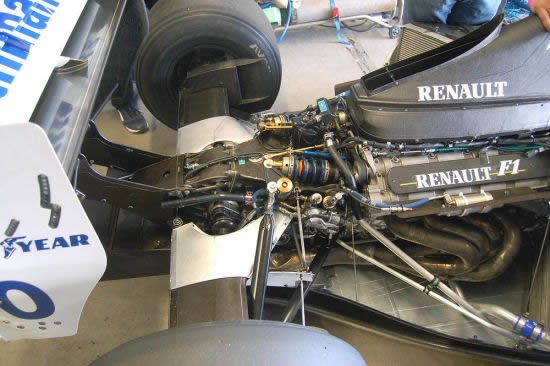 |
Exhaust blown diffuser on Renault RE40 (V6 Turbo) F1 |
The blowing effect of exhausts is not a new thing, and has been a factor in Formula 1 since 1983 when Renault first routed their exhausts into the diffuser aft of the flat bottom on the RE40 (V6 Turbo), idea first conceived by Renault’s Jean-Claude Migeot. Migeot actually routed both exhaust and turbo wastegate flow directly into the diffuser. Back then the diffuser was 1000 millimeters width and not split like the current versions are (due to the step plane regulations).
Before this everyone had routed the exhausts into the area of least influence, usually above the gearbox or with long pipes through the rear suspension. This created no downforce benefits. On most cars of this era, the exhausts were treated, at best, as aerodynamically neutral elements, or at worst as disruptive devices. This is understandable because, in general aerodynamic terms, exhaust jets are particular examples of round jets, a type of turbulent flow. Exhaust jets are sources of heat and turbulence, neither of which appear, at first sight, to offer any beneficial contribution to downforce.
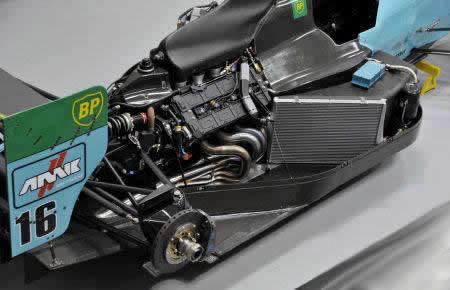
Blown diffuser on MARCH-911b Formula 1 car. |
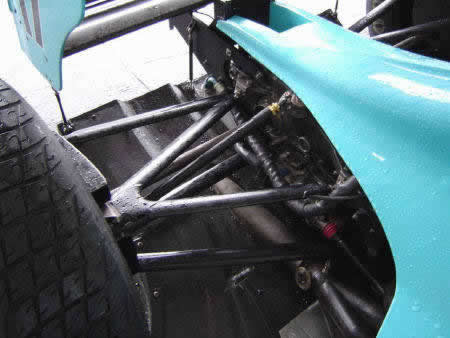 |
But the effect of the exhaust gases speeding up air flow through the diffuser, was improving venturi effect under the car, energizing the flow and thick boundary layer, and in this way powering the diffuser will gain more downforce without drag penalty.
The downside was the almost an ON/OFF effect (throttle position and quantity and speed of exhaust gases) of the exhaust blowing during the course of the lap varying the downforce effect. Idea of blowing into diffuser was excellent but was not very successful. Problem was that exhaust gases don't have constant speed. More driver press the throttle pedal, higher the speed and quantity of the exhaust gasses and better efficiency of diffuser. Less throttle, lower the exhaust gasses speed. With lower speed of gasses, diffuser efficiency will drop and driving with lower downforce on the back of the car is not so pleasant thing to do. The worst part of the story is that during the cornering, when you need more downforce, drivers usually need to lift a foot a bit, losing downforce where they need it more. Read later more how this effecting RedBull RB06 and 07.
Turbo-charged engines are not critical to exhaust tuning (pipe length and position), and ones the exhaust gases have passed through the turbo charger they have much constant speed and slowing lag. It was during the turbo era that aerodynamicists discovered that using the exhaust gas flow to blow the diffuser of the flat-bottomed cars, increased the air flow extraction under the car and so increase downforce. The move away from turbos and their effect of smoothing the flow out of the exhausts made this a bigger problem. As we sad before, when the driver lifted the throttle, the flow reduced and the downforce reduced. From this time on, exhaust system design has been a compromise between aerodynamic needs and power, and the two departments (aero and engine) have strenuously researched the affects in order to make their individual cases as priority.
When diffuser blowing first came in, the exhaust was arranged to blow tangentially along the surface of the inclined diffuser. The high velocity gases entrained air, energizing the thick boundary layer, and effectively powered the diffuser as it drew air under the car. The fact that the throttles controlled the gas flow would appear to contravene the regulation that prohibits any part of the car that affects aerodynamic performance from being moveable. However, wherever the exhaust exited it would affect the aerodynamics, so diffuser blowing has escaped the regulation on the basis that if it was banned, all exhausts would be illegal.
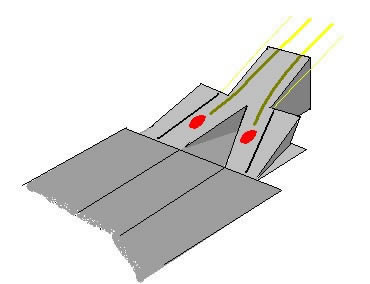 During the construction of an F1 car, wind tunnel models of the Formula 1 car incorporate small, ejector-type, air driven pumps that simulate the air flow into the ram intake and doubled it as the exhaust flow. The effect of throttle-open and -closed can be tested and the changes in downforce and, more importantly the centre of pressure of the car can be measured. In recent years, the effect of the exhaust on the centre of pressure, and its variation with throttle opening have led to the true blown diffuser being abandoned, and exhausts exits moved to blowing over the top of the lower body rear edge. In this position, they probably did more to increase the radiator air exit flow than influence the underbody flow.
During the construction of an F1 car, wind tunnel models of the Formula 1 car incorporate small, ejector-type, air driven pumps that simulate the air flow into the ram intake and doubled it as the exhaust flow. The effect of throttle-open and -closed can be tested and the changes in downforce and, more importantly the centre of pressure of the car can be measured. In recent years, the effect of the exhaust on the centre of pressure, and its variation with throttle opening have led to the true blown diffuser being abandoned, and exhausts exits moved to blowing over the top of the lower body rear edge. In this position, they probably did more to increase the radiator air exit flow than influence the underbody flow.
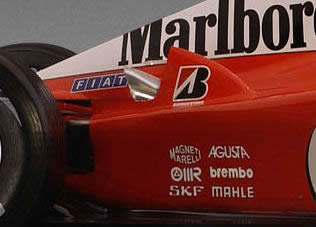 However, two further trends have led to Ferrari considering and then adopting an alternative exhaust arrangement. In the quest to move weight forward that has resulted from the width limitation on the rear tires and the grooves in the treads which led to Bridgestone introducing a wider front tire in 1998, the engine has moved forward relative to the rear of the bodywork, defined in the regulations by the rear axle centre line.
However, two further trends have led to Ferrari considering and then adopting an alternative exhaust arrangement. In the quest to move weight forward that has resulted from the width limitation on the rear tires and the grooves in the treads which led to Bridgestone introducing a wider front tire in 1998, the engine has moved forward relative to the rear of the bodywork, defined in the regulations by the rear axle centre line.
At the same time the peak RPM of engines climbed relentlessly upward, now 18,000rpm. Thus, while exhaust pipes needed to become shorter to stay in tune with the higher RPM (higher RPM-s - shorter pipes, Lover RPM-s - longer the pipes), the exhaust pipes had to be longer to reach the trailing edge of the underbody. For Ferrari, the arrangement that provides for nearer optimum length exhaust pipes, by leading them the short distance from the engine to an exit port set into the top surface of the bodywork (chimney), is better than one that still blows into the base region around the trailing edge of the diffuser.
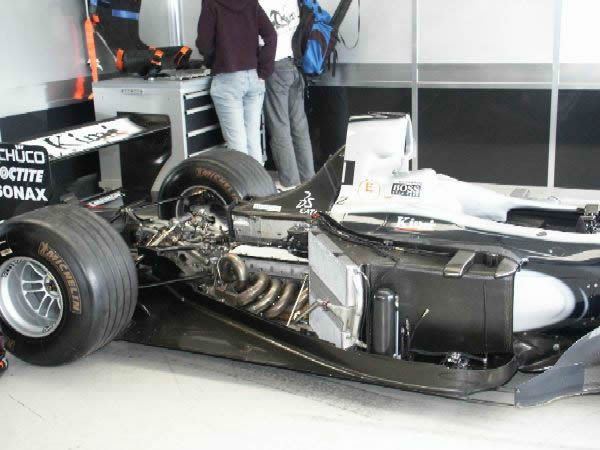 |
Blown diffuser on McLaren MP4/17. Not in the exactly in the plain view, but you have idea |
In this time, Adrian Newey's McLaren MP4-17 blows the exhaust into the centre of the diffuser to improve the flow along the step lane and under the plank. Problem was very strong ON/OFF effect produced during throttle lift.
Besides this two, there are not many other areas that exhausts could route to gain benefit. You need to route the exhausts around the rear of the sidepods somewhere, so there is a limit to the flows that can be affected, plus they cannot route beyond the rear edges of the diffuser (it's in the regulations). Exhaust gases can be used for speeding flow up where it is low energy or bad quality (along the step plane, McLaren), or for further speeding up flow over and aerofoil (rear wing/flip ups, Ferrari).
The FIA has acted several times since the mid eighties to cap the potential of the diffuser by reducing its length, height, ride height and position relative to the rear axle. Moving air through the diffuser is the key to it producing downforce, or Mass flow as the aerodynamicists call it.
Onset airflow is another factor controlled by the front wing, bargeboards and the floor itself, but this is somewhat capped by what can be achieved with the limited devices the rules allow for.
Then there is the flow over the top of the diffuser, this has been perhaps the biggest area of development in recent years. By ending the diffuser with a gurney flap, the airflow over the top of the diffuser can actually aid airflow extraction underneath the diffuser. This is the reason sidepods have become slimmer, undercut and the diffuser appears more exposed amongst the coke bottle bodywork. Effectively the harder the air flows over the diffuser, the more powerful the gurney can be in puling airflow from inside the diffuser; this makes the diffuser act as though the exit is larger and makes more downforce.

With 2009 downforce reduction rules, the diffuser continues to be the dominant factor in aero design. Making the most of creating low pressure under the rear of the cars bodywork is as important as ever. Last year (2009) we saw teams exploit rule loopholes to create additional underbody air inlets feeding and energizing larger exit areas, known as the double diffuser. This year teams have further exploited these rules for ever larger inlets and outlets.
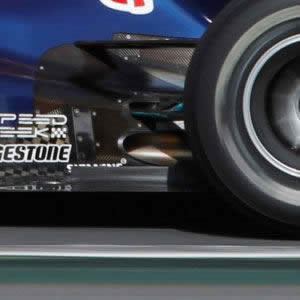 However it has again fallen to Red Bulls Adrian Newey to look at the history book and re-invent a concept that has since fallen out of favor. Last year he did the same with reinvention of the pull rod rear suspension and this year it has been the exhaust driven diffuser. By mounting the exhaust outlets in line with the floor, they blow through and over the diffuser driving greater airflow and hence creating more downforce.
However it has again fallen to Red Bulls Adrian Newey to look at the history book and re-invent a concept that has since fallen out of favor. Last year he did the same with reinvention of the pull rod rear suspension and this year it has been the exhaust driven diffuser. By mounting the exhaust outlets in line with the floor, they blow through and over the diffuser driving greater airflow and hence creating more downforce.
Red Bull surprised everyone with their revised car that appeared on the last day of 2010 preseason testing. The RB6 car sported revised exhaust systems with a low exits. Although it was first tested with the conventional RB5 exhausts, it was only at the last test day the team unveiled the secret exhaust development. Even replacing the old exhausts with look-a-like stickers to fool the unwary.
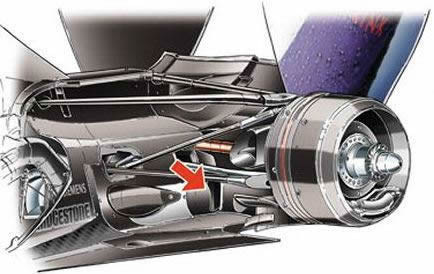
The RB5 that preceded 2010 year's RB6 car, already had high placed rear wishbones, and this allowed the subsequent car to run exhausts mounted low down and exit well below the wishbone, avoiding any overheating issues of the carbon fiber suspension components. Teams have run exhausts in very close proximity to the wishbones now for many years, the differing strategies teams employ reduce the thermal load on the carbon fiber wishbones. Either gold foil film, extra carbon fiber heat shield or these are often coated with ceramic finishes to reflect heat. (Check on the heat shielding article here).
Contrary to the popular belief, the low exhaust position is not related to the Red Bulls Pull rod suspension; in some respects having the exhaust in close proximity to the pull rod/rocker linkage is undesirable. But the exhaust positioning is probably more sensitive to wishbone position, so much that teams aiming for low wishbones may have problems packaging the exhaust exit under the suspension. McLaren and Virgin Racing have notably low wishbones.
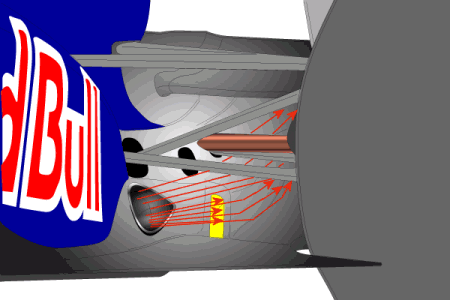
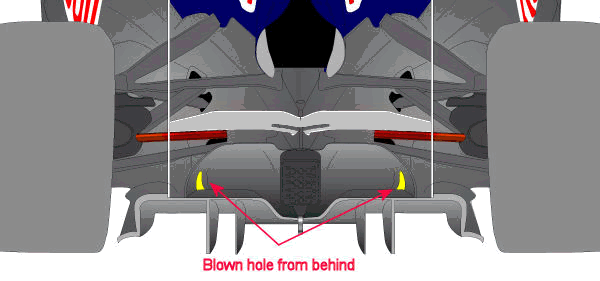
However, the Newey designed solution on the RB6 is a little more complicated than it first appeared. In the RB6's case Newey made a vertical window in the diffuser to allow the diffuser to be blown both under and over by the exhaust. This helps the airflow going up the outside shoulder of the upper diffuser deck, which probably has little energy and struggles to keep attached, and the high speed exhaust gas will drive more flow through the diffuser to increase downforce.
Criticism aimed before at exhaust driven diffuser is their sensitivity to the throttle. As we see before, this issue was mainly related to when the exhausts were placed right on the kickline between the floor and diffuser, thus ON/OFF effect on downforce was much more pronounced. Plus, the placement of the exhaust exits some way upstream of the diffuser should allow a better compromise between downforce and sensitivity. Newey knows a thing or two about blown diffusers, the McLarens retained diffuser exhausts exits all the way to the MP4-17, even then the switch to periscope (chimney) exhausts was largely driven by other engine packaging factors. Even the still born MP4-18 aimed to have diffuser exiting exhausts.
One of Red Bull's secrets is a setting and mapping on the Renault engine. These work by teams forcing fuel through the engines even when the drivers are off the throttle in a practice known as 'off throttle overrun'.
Red Bull pioneered the technology 2010 and maximized it 2011 with great support of their engine supplier Renault. Actually, that's not some new invention. This kind of engine management is in use in rallying to prevent turbo lag. And Renault have great experience with rally cars. All big engine manufacturers develop some kind of engine mapping, be it cold or hot blowing. It's not so easy to do. When you run an engine on dyno with new mapping, its not easy step to fit it on the car and just run it. A lot must be changed in car and brake setup because new mapping with blowing included fundamentally changes the braking balance and behavior of the car.
On the end of 2011, 'off throttle overrun' was banned by FIA. But what exactly is 'off throttle overrun' (hot and cold blowing) and what is being banned here?
Cold blowing – Normally the engine will only produce enough exhaust gases when the driver is on the throttle. This means when the driver lifts off, the blown diffuser is suddenly robbed of the additional airflow. To improve the situation, some teams get an idea. When the driver lifts off the throttle pedal the engine throttles go to 100% open and it cuts all the fuel and the spark, so there is no drive from the engine but all the air is flowing through the engine to give about 75% of the exhaust pressure you get on the power. Now engine is running as air pump. The exhaust is still ‘blowing’ into the diffuser, but that airflow is ‘cold’ since no fuel or ignition are involved. Everyone has been doing this for the last 12 months.
Hot blowing – For the last two or three months some teams have taken things a step further. In hot blowing they cut the ignition when the driver lifts off the throttle, but continue to inject some fuel through the engine’s valves into the exhaust to increase the energy into the gas. This fuel is not igniting inside the engine cylinders, but pass trough and ignites on the hot exhaust, increasing the amount, speed and temperature of the airflow exiting towards the diffuser. So they end up with more downforce. To do that they have to retard the ignition and kill the torque, because if you don’t then the engine is going to create torque and the engine is going to keep going when the driver lifts off the throttle. Clever engine maps prevent the engine pushing the car on in these conditions by retarding the ignition by as much as 35-40% on the over-run. By retarding the ignition when the driver lifts off, the fuel is no longer burnt inside a closed combustion chamber, but instead the fuel and air burn in the exhaust pipe, the expanding gasses blow out of the exhaust exit as though the engine is running . This creates a more constant flow of exhaust gasses between on and off throttle. This maintains the performance of the blown diffuser and keeps the downforce up when it's most needed. In this way they managed to avoid the main problem of an exhaust blown diffuser whereby when a driver lifts off the throttle for a corner, the downforce goes missing when you most need it and the rear stability changes.
It's not something you can do for all duration of the race as the engine temperatures go sky high, which damages the engine, but it gives that vital fraction of a second which keeps Red Bull ahead of the rest in qualifying. The problem here is that the engine mapping uses more fuel and creates excessive heat in the exhaust pipes and at the exhaust valve. Renault reported that both Red Bull and Renault used 10% more fuel in Melbourne compared to last year, most likely due to these off-throttle mappings.
Another misconception of the low exhaust is the effect on tire temperature. It's possible that the exhaust does affect the inner shoulder of the rear tires, but this may well be an effect teams want to discourage. Any complete tire heating will certainly be secondary benefit of the system and the sole reason for going with low exhausts. It's interesting to note Red Bull have run a fence on the floor between the exhaust and rear tire. This probably helps keep unwanted heat from the tires. But in Canada, where tire temperatures were low, this fence was removed. It could be that the tire heating effect could be a tunable parameter, by varying the heat shielding around the coke bottle area.
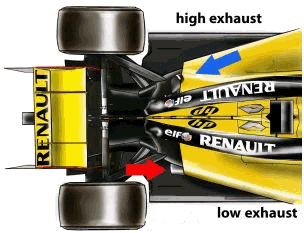
Of course, other teams want to dissolve RedBull advantage, and start to develop their own blown diffusers. So far we have seen Ferrari, Renault and Mercedes have followed Red Bulls 'back to the future' exhaust/diffuser solution on 2010 European GP in Valencia. McLaren and Williams are expected to follow for the next race At Silverstone. Ferrari, Renault and Mercedes start the race with a diffuser blown only over the top, without window, which perhaps offers less potential then a through blown diffuser, but at least will be legal next year when double diffuser is banned by new rules, and preventing openings in the diffuser. The blown element operates independently of the "double" element of the diffuser and whereas double diffusers are banned from next season, the blown diffuser is here to stay.
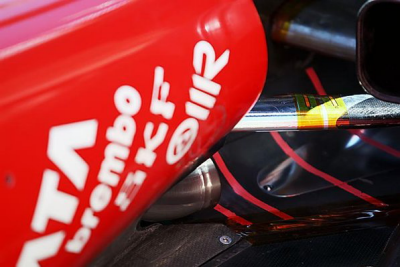
On the end of 2010 season, Ferrari perfected their own blown diffuser. In the place of vertical windows used by RedBull racing RB6 racer, Ferrari employed horizontal slots over the top of diffuser.
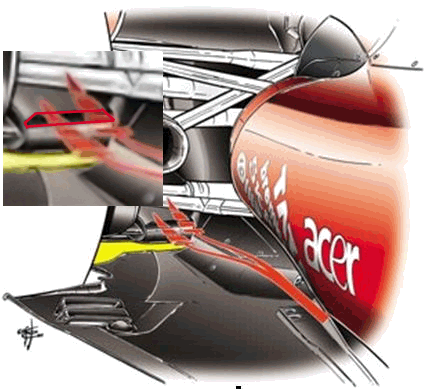
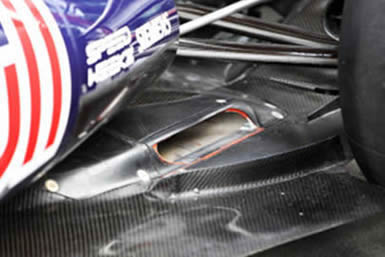 |
The neatly-packaged Red Bull exhaust exit in the beginning of 2011 |
A blown diffuser increases downforce on all corners, with the greatest effect on medium to low speed corners. The exhaust-blown diffuser is most effective on the exit of 80-100km/h corners where, if he stands on the throttle, the driver gets lots of extra downforce relative to the level of downforce the car already has. It becomes increasingly less effective the faster the car goes. That's the reason why is Red Bull so strong on the tracks with medium speed corners.
BTW, Red Bull Racing clinched both the constructors' championship and the drivers' crown with Sebastian Vettel, with the victory in Abu Dhabi, the last race of 2010 season and Vettel become Formula 1's youngest-ever world champion, only 23 years old. This is all the proof that is needed about how good the outfit is now, with Adrian Newey as technical director and main designer.

In 2011 the top teams focused a lot of resources on extrapolating aerodynamic performance from their car's exhaust gases. By channelling the gases through the diffuser the teams boosted rear downforce and they also developed engine maps that meant the gases continued to flow even when the driver was off the throttle.
For season 2012 FIA has outlaw blown diffusers and teams are forced to run with periscope exhausts. Formula 1 teams have been told that there will be stricter limitations on engine mapping next year, as part of a clampdown by the FIA to prevent teams exploiting exhausts gases.
With the FIA keen to ensure that off-throttle blowing of exhausts does not continue, the governing body has issued a Technical Directive to teams informing them that there will now be severe limitations on what is allowed next year. FIA has made it clear that the 2012 version of the software used by F1's standard ECU will now put certain limitations on engine mapping. Although the positioning of exhaust tailpipes will be more tightly controlled, there is still some potential for off-throttle engine mapping to be heavily exploited.
Although the FIA move was not delighted all teams, with some expressing reservations in a meeting of the FIA's Technical Working Group, the majority of outfits have welcomed the move - because it effectively removes a grey area of car development.
The FIA argued earlier this season, during an intended push to ban off-throttle blown diffusers which eventually had to be abandoned, that such extreme engine maps were a breach of the famous Article 3.15 of F1's Technical Regulations.
This was based on its view that there was an aerodynamic benefit from a moveable part (engine and throttle), plus it was being influenced by the movement of the driver through the throttle. Neither are allowed in the rules. This new hanges to the technical regulations have thrown things back into the melting pot and it remains to be seen who has done the best job of re-interpreting them. Change in exhaust exit pipe position, diameter and profile led to loss of rear-end downforce, sending aerodynamicists searching for fresh ways to regenerate it and rebalance their cars.
New positioning of the exhaust pipes exits and limitations are shown on picture below. Exits of the pipe can be positioned inside green box with exhaust tailpipe pointed upwards.

But this was not sufficient to eliminate exhaust-blown diffusers. Well, the first thing to note is that it is not possible to point the exhaust exit down at the diffuser in same way as before, this will not necessarily prevent the exhaust jet itself from blowing in that direction. When an exhaust jet exits into a cross-stream of fresh air, the exhaust jet bend with the air stream, effect called "Downwash".
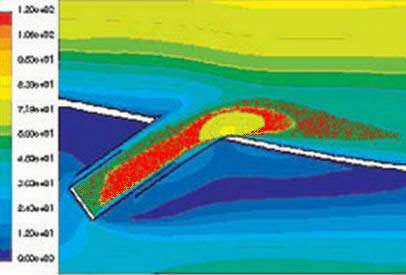 |
Picture from paper published by F. L. Parra and K.Kontis in their 2006 "Aerodynamic effectiveness of the flow of exhaust gases in a generic formula one car configuration" |
If the exhaust exit is placed flush in the rearward face of sidepods sweeping downwards at a fairly steep angle, then the free stream airflow could deflect the exhaust jet downwards in direction of the diffuser. The degree to which the jet is deflected is determined by the ratio between the velocity of the jet and the velocity of the cross-stream flow. The smaller the ratio, the more the jet is deflected. This effect is well documented and often termed “jet in cross flow”.
After that, coanda effect (Coanda – The tendency of a gas or liquid coming out of a jet to travel close to the wall contour, even if the wall’s direction of curvature is away from the jet’s axis) will take over and "glue", now energized air stream (mixed with exhaust jet) to the bodywork. Basicaly, coanda effect dictates that gases will stay attached to a surface they are directed along. Of course, secret is to design this part of the bodywork and bodywork in front of the exhaust exit in the way to optimize this effect and give a proper and exact route for gasses to flow in direction we want. Effect of diffuser blowing is not as strong as before, but with clever design and optimization you can get few percent of download more. With this set up the exhaust plume is curved downwards by both the shape of the bodywork aft of the tailpipe (coanda) and by the airflow passing over the sidepod (downwash).
During 2012 pre-season testing, already few teams come with this new solution. Sauber Racing and McLaren found a way of shaping the sidepod and exhaust fairing to use these effects. They where able to consistently direct the exhaust jet at the gap between the diffuser and rear tire. McLaren’s exhaust\sidepod solution has proven to be the most widely adopted and has been termed a "Coanda" exhaust by the media. Even though it’s arguably an inaccurate term, as the downwash effect is probably greater than the Coanda effect in comparison to other sidepod shapes, such as Red Bull’s. They come first, and then Ferrari, Force India, Toro Rosso, Sauber and Caterham , followed by Williams and others. Lotus was the last team to follow the trend for the Coanda-effect exhaust system, introducing it from Friday in Korea GP on Kimi Raikkonen's car, providing exhaust-boosted airflow over the rear brake ducts and around and over the diffuser sides. Kimi continued to use it in qualifying and race, while team mate Romain Grosjean kept the old, central-blowing exhaust, which provides slightly more engine power. This leaves just Red Bull following the fully ramped sidepod design, and HRT remain with a simple periscope exhaust set up.
Diffuser has low pressure inside, this will draw in high pressure airflow from outside the diffuser reducing its downforce. Additionally, the tires wake sends an unwanted jet of airflow into the diffuser, known as ‘tire squirt’.
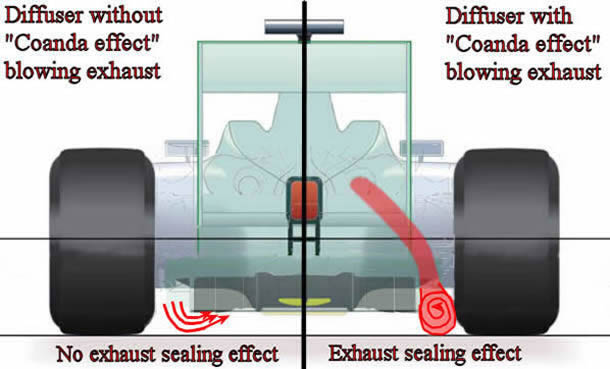
Unable to blow directly into the diffuser since the 2011 rule changes, the gases are guided down channels inside the rear wheels, sealing the gap between the tires and the outer side of the diffuser and this serves as skirt to seal the side of the diffuser from leakage. Having the exhaust blow along the diffusers edge keeps these pressure regions separate and prevent the tire squirt upsetting the diffuser. Preventing these effects means the diffuser creates higher levels of downforce at the high rear ride-heights and large degrees of car rake and is more efficient. And an additional benefit is it means the team can run a higher rear ride height, which effectively makes the diffuser larger and further increases it’s potential to make downforce.
During 2013, last year before radical changes in engine, exhaust and ERS, Red Bull, Lotus and Sauber were the only teams who have their rear bodywork designed and optimized in such a way as to guide the exhaust gases all the way down to the area they want them - and Sauber have only done it in the last couple of races. Other teams tried to follow their lead, but with more or less success.
As far as I can see it, during 2011, 2012 and 2013, Vettel was only person who drives in a fashion aimed at using this to best effect. The rest of the field have it on their cars but have not adapted their driving style to use it as well as possible. And system itself was not as good as Red Bull's. Without doubt they push everything in this area to the limit but that is there for everyone to do. Vettel go with the fact that it will give him more rear grip if he nails the throttle very early after apex, so he does that.







